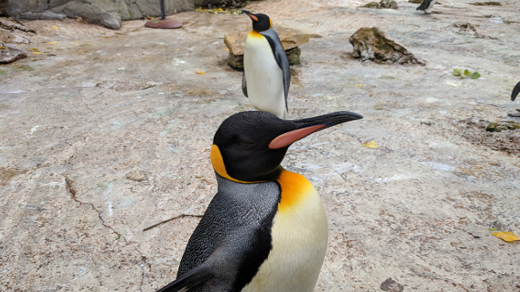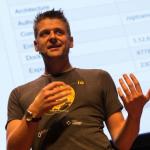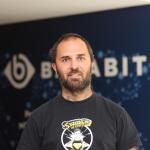The Linux mascot is a penguin named Tux, so we thought it appropriate to celebrate Penguin Awareness Day for the conservation of penguin habitats and talk a little bit (more) about Linux.
A few fun penguin facts: These furry creatures are flightless yet part of the bird family. Some are large, like the Emperor penguin, and some are small, like those found in New Zealand. And, the Gentoo penguin is known to swim up to a speed of 21 miles per hour!
Now, for the Linux bit. I asked our writer community to describe the moment they learned about Linux or the moment they got it up on running on their machine. Here's what they shared.
Simon Pincus, VP of Engineering at Opengear
From my perspective, there was a significant turning point in the market’s acceptance of Linux in 2008. As a development manager, my teams had, naturally, been making use of various distributions for some years as development and test environments. But from a sales and marketing perspective, we had achieved little traction in convincing customers to use Linux with our applications in production. That changed remarkably quickly and, personally, there was a single meeting with a customer that made me realize the winds had shifted.
I was meeting with the CTO of a major telco in Europe. I was presenting technical architecture of an application and had launched into recommended environments. As always I started by recommending Linux and turned immediately to my defense of the stability, security, reliability of the platform for mission-critical applications (a presentation that was generally met with blank stares).
The CTO interrupted me and said "no need to convince me of any of that: we're going to use Linux heavily from this point onwards. Just tell me how soon we can get it." At that moment I knew the battle was over!
Chris Hermansen, Community Moderator, Community Engagement Consultant
In the fall of 2005, I still had a Sun Workstation on my desk at work, but my family was preparing for a year away, and since I was going to continue working, I decided to buy a big, fast laptop for my computing needs. It turned out to be a very nice Toshiba running Windows XP, but even with MinGW installed, I found after a couple of months I wasn't getting the kind of productive environment I needed.
I had tried Linux before, but I always returned to my trusty Sun—mostly because PC hardware wasn't that great back in the 90s. But this time, I wasn't going to have the Sun as an option, so I downloaded a newish distro called Ubuntu and installed it on my laptop. And on that decent hardware, to my surprise, I not only found Linux to be really good, but I also found the ensemble to be way better than my Sun. It was a better GNOME experience, it had a way better and more up-to-date package selection, and was often faster. So, not only did I replace Windows, but I also moved on from Solaris.
When I returned from our year away, I ordered a new Dell desktop for my office and installed Linux on it. I've never looked back.
Jay LaCroix, IT Director
I got started with Linux in 2002 at a community college that was doing a pilot Linux class. I was so infatuated that I read the textbook completely before the first day of class. Each student was given their own hard drive to install Linux on, and we treated the installation as our own and maintained/improved it throughout the class.
Later on, I was asked to activate my copy of Windows XP after I'd reinstalled it too many times, which offended me. It was my computer, and I was basically locked out of the machine and unable to log in until I called Microsoft and verified my installation. Considering my newfound knowledge of Linux from the class I took, I decided to install Red Hat Linux and learn how to use it as my daily OS. I enjoyed having complete freedom on my machine without having to deal with licensing or activation. I've since moved to Fedora, then to Debian, and now to Ubuntu (and several in between).
Maxim Burgerhout, Senior Solution Architect and Part-time Evangelist
I got started with Linux right before the turn of the century when I was in law school and worked part-time in a local computer store. We actually sold boxed Red Hat Linux, which was my first distro. Shortly after, I switched to working part-time for the university as a teaching assistant. This was around 1999 or 2000, I think. I started using Linux full-time on the desktop around that time, switching between every conceivable distribution known to man, just to learn as much of it as possible.
Part of my job as a teaching assistant was to explain what the internet was to other law students (remember, this is almost 20 years ago!). During my classes, I largely regurgitated what I had learned from downloading, installing, configuring and running Linux. Linux was nowhere near as polished as it is today, but it was a great way to get your hands dirty and learn how computers really work. And it still is!
Scott Nesbitt, Community Moderator, Writer of Stuff
While Linux had been on my radar since around 1994, for a handful of reasons I never gave it a try. That all changed in 1999, when my computer running Windows 98 crashed, taking a whole lot of work with it. A couple of days later, I was at a Staples office supply store and saw a boxed copy of Caldera OpenLinux on sale. I decided to lay out $20 and give it a try.
Around that time, my wife got a new desktop computer so I grabbed her old one, slipped the installation CD into the drive, and within 20 or 30 minutes I had a working desktop. Since then, I haven't looked back. No more worrying about licenses or expensive software. I can focus on getting things done. Over the years, I've upgraded and salvaged a number of desktops and laptops (both my own and those belonging to friends) using Linux.
Bertrand Delacretaz, Principal Scientist at Adobe, Member and Director of the Apache Software Foundation
I started with Unix back in 1985. (I sense the #oldfart hashtag coming.)
My first serious Linux project was in 2004 when we created a Linux-based video player and multimedia kiosk for an exhibition that toured Switzerland for several years. The users manual for the set of players and kiosks was written to explain how to turn the power on in the morning and turn it off in the evening. The operators were not expected to have a clue about Linux or computers, and having to travel to fix these things would have killed our tight budget.
Creating such a robust, turnkey system with large disks for the media (so not really embedded) was a serious challenge at that time. But, it worked beautifully with almost no service calls during the multi-year exhibition tour. Getting high-quality playback of digital video was also challenging back then, but the building blocks approach of Linux meant we could get everything right and create a heavily-customized system that did a great job.
That's when I realized Linux was here to stay.
Steve Morris, Director of Information Technology at Ambrose University
My discovery of Linux happened in the early 90s. I had a shell account with a local ISP and had to research Unix to figure out how to use it. Through a search engine, I learned more about Linux, specifically Slackware. My first install was either via floppy disks or CD-ROM, but I do remember clearly and fondly the moment after saying out loud: "Great! Now what?"
Thomas Hamilton, Technical Support Engineer at Red Hat
I went to college in 2003, which meant I needed a new laptop. It came with Windows XP. These were the early years where some laptops could boot from USB and some could not.
Over the next few years, my CD/DVD drive quit working, so I just got an external one for the times I needed to use it. No biggie. Eventually, though, Windows gave out. There was no optical drive to boot from, and USB isn't a bootable option on this laptop. I tried removing the hard drive, installing it in another computer, installing XP on it from there, and putting it back in the laptop. To no ones surprise who has tinkered with Windows, this didn't work.
I had heard of Linux and had briefly used it in my computer science classes (a pre-enterprise version of Red Hat Linux), and happened to stumble across some live distros that I could download (for free, legally) and try out. These were Knoppix and Puppy, if I remember correctly. These were cool, but they weren't full installs and still didn't let me use my laptop. The breakthrough came with gOS, a variation of Ubuntu 8.04. It was pretty, it ran well, and the live image also let me install it. Remember how Windows can't be installed on one computer and then moved to another? Well, Linux can!
I was able to take the hard drive back out, put it in another computer, install gOS, put it back on my laptop, and it worked. I still dual-booted various Linux distros over the years with different versions of Windows on several other computers for the next few years, but thanks to gOS I saved me a few hundred dollars on a new computer that I otherwise didn't need to spend money on as a broke college student. I knew there were other (better) alternatives to Windows out there, and I have now been Windows-free for nearly 8 years. It just gets better and better.
Jim Hall, Creator of FreeDOS
I was a university student at the time and frequently used the Unix computer labs on campus to run data analysis programs for my physics labs. I used DOS on my home computer, but using those big Unix systems had spoiled me, and I wanted more. I began to look around the discussion groups, and someone mentioned this new thing called "Linux." It was a Unix-like operating system, but it ran on PCs. I could run it on my '386 computer.
I was immediately attracted to a free Unix-like system that I could run at home, without having to dial into the campus computer network all the time.
I installed SoftLanding Systems Linux 1.03 from a stack of floppies! I don't even think there was a CDROM option at the time. SLS 1.03 came with Linux kernel 0.99 alpha patch level 11 and required a whopping 2MB of RAM, or 4MB if you wanted to compile programs, and 8MB to run X Windows. It worked great! After booting Linux for the first time, I was pleasantly surprised to find familiar tools: awk and sed to manipulate files, less and cat to examine files, and GNU Emacs for editing. For more advanced work, I had gnuplot to display data, gcc to write my own utilities in C, and f2c to write custom data analysis tools in FORTRAN.
I graduated in 1994 with a bachelor's degree in physics, but using Linux started my career as a Unix systems administrator. I never looked back.
Peter Czanik, Syslog-ng Evangelist
The first time I encountered Linux was when I entered university in 1994. I went to the faculty IT department asking for an email address when not even teachers received one automatically. When I got the email address I was also invited to be part of the student volunteer group at IT. At first, I got user access to a FreeBSD server, but soon I got the task of installing Linux on a spare box. It was Slackware from many floppy disks on an i386 with four megabytes of RAM.
Soon I had Linux up and running also on my home machine. At the time it was only my secondary OS and I still used Windows as my desktop. I tried a few distributions, installing them both at home and on my university server: Red Hat Linux, Debian, and then Jurix, which you have most likely never heard of.
Jurix was a one-man show, a rolling distro with a strong focus on security. And I really needed that: Foreign students of the university were constantly attacking our servers, but as they were paying students, they could not be punished. Soon, Jurix became the basis of S.u.S.E Linux, and I have been using it as my primary desktop OS ever since, surviving its name changes from SuSE, to SUSE, and now finally to openSUSE.
Rachel Kelly, Cloud and FOSS Enthusiast
Looking back, my relationship with Linux now is obvious. My pops was an early adopter of home computers, and my two brothers have been programmers all their lives. I was very fortunate that it was always around. Until 2010, however, when I began volunteering in the Build program at Free Geek, I had had only limited direct exposure. In Build, I was one of many volunteers taught to build Linux computers for other volunteers who had met hour requirements in the recycling center, and for Free Geek's storefront. To move up from level to level, you, with support, teach the incoming cohort what you have learned. This model of instruction by empowerment is one I hope to take with me always. And, getting to know Ubuntu 10.04 was such a gift, with even a skosh of a command line.
Several years later, I found myself using these skills during my Introduction to Python class when I returned to university as an adult. A woman in my class told me about PyLadies, the international meetup for women Python programmers. It was there that I studied enough bash to use the command line comfortably, then learned Python in order to develop several projects in service to finding my first job after completing my degree. It was an internship that gave me a serious view into so many levels of a modern tech stack.
Finally, after four years of using a Mac at work, I have made the full-time switch for my work and personal projects to Linux, specifically Kubuntu (though I've enjoyed Unity, Mint, Fedora, and even took a whirl with Kali). I love its accessibility, package availability, and terrific desktop environment. The ethics of freedom in the Linux community, and the people who work so hard to make this a welcoming place are invaluable to me and to us all. I just hope to be able to return the favor.
Open source community shoutouts to PyLadies PDX and SeaGL!
Spencer Hunley, Contracted Support Specialist
My Linux journey started when I was in college, still struggling to maintain a Windows XP system on an older laptop. In one of my basic tech classes the professor booted up Red Hat Linux for us one day, and I was immediately interested. Up until that point I had never heard of any other operating systems, free/open source or otherwise, that didn't come pre-installed on new computers. I visited him in his office after class and he took the time to show me Ubuntu, he even ran it live on my laptop. I couldn't believe something so substantial didn't have a price tag associated with it.
Soon after, I dual-booted my system, but mostly ran in Ubuntu; it felt brand new, with more control than I've ever had. As I discovered more, tried other distros, messed with various parts (sometimes learning from breaking things and having to fix them), I moved entirely to Linux. Locally, I've held a few casual seminars about Linux for those who are curious, looking to refresh their old hardware, or just want an operating system that stays out of their way and adapts to them, not the other way around. Without Linux, I wouldn't be where I am today.
Share your Linux story with us in the comments.


















22 Comments